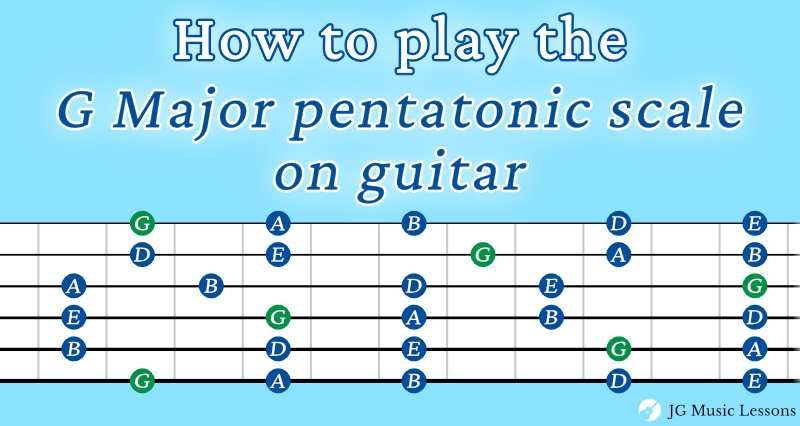In this lesson, we’re covering how to play the G Major pentatonic scale on guitar by learning the 5 scale shapes on the fretboard as well as the music theory to help you understand how it works.
The pentatonic scale is a powerful 5 note scale that you can use to create tasteful and melodic ideas for improvisation. If you missed the lesson on the difference between Major and minor pentatonic scales, check it out here.
Grab your guitar and let’s get started!
Major pentatonic scale formula
If you already know the Major scale, learning the Major pentatonic scale is very simple. The Major pentatonic scale is made up of these 5 notes which come from the Major scale: the 1st, 2nd, 3rd, 5th, and 6th scale degrees.
For example, the G Major pentatonic scale has the notes G, A, B, D, and E. This is essentially the G Major scale without the 4th and 7th scale degree.
You can also create the scale using a whole and half step formula between each note. The Major pentatonic scale formula would be whole, whole, 1.5 whole steps, then whole, 1.5 whole steps. See the example below.

Or, you think of the notes in the scale in terms of intervals related to the root note. The intervals in the Major pentatonic scale are: unison (with the root note), perfect 2nd, Major 3rd, perfect 5th, and Major 6th.
As a side note, the G Major pentatonic scale shares the same notes as the E minor pentatonic scale.
Now that we covered the music theory, let’s start learning the 5 scale shapes throughout the guitar fretboard.
5 G Major pentatonic scale shapes on guitar
This section covers the G Major pentatonic scale shapes throughout the guitar fretboard. Each shape includes music notation with guitar tabs to show you what fingers to use when playing the scale.
How to read the scale charts
For the charts below:
- The left side of the charts shows you the scale notes and the right side shows you the suggested fingering.
- The lowest horizontal line represents the thickest string (Low E) and the top horizontal line represents the thinnest string (high E).
- The green circles represent the root note of the scale and the blue notes are every scale note in between.
- Circles to the left of a chart represent open strings.
If needed, check this link for more on how to read guitar notation symbols.
Scale shape 1

For the notation below, the numbers above the notes suggest what fingers to use for your fretting hand.

Scale shape 2


Scale shape 3



Scale shape 4


Scale shape 5


Connecting G Major pentatonic scale shapes
Finally, here is what the G Major pentatonic scale looks like across the entire fretboard if we connect all the shapes.

3 tips for memorizing the Major pentatonic scale shapes
Here are 3 quick tips to help you memorize the 5 Major pentatonic scale shapes.
1. Master one shape at a time
The way I recommend learning and memorizing any scale is to start with one shape that feels most comfortable for you. Try to really get the shape under your fingers to the point where you don’t have to look at the chart. Use the first shape you master as a guide to learn the other scale shapes around it.
2. Look for repeating fingering patterns
Look for patterns such as what strings repeat the same fingering within a shape.
Tip: The notes on the first and sixth string will always be the same.
For example, in shape 3 we see that the 1st, 2nd, and 6th string follow a 1 and 4 finger pattern. The 3rd, 4th, and 5th string follow a 1 and 3 finger pattern. Knowing where note patterns repeat will help you build a mental map of a scale shape.
3. Connect shapes around the ones you learned
After learning one of the scale shapes well, either learn the shape that comes before or after it to see how the notes connect on the fretboard. Again, try to master one shape at a time and make sure you can play it without looking at the chart. This will make the process more approachable by breaking it down into smaller sections before moving on to the next shape.
Wrapping up
We covered how to play the 5 scale shapes to play the G Major pentatonic scale. It may seem challenging to break out of your comfort zone if you’re used to playing the pentatonic scale in one area but it will be worth learning!
You can then use these shapes to start on different root notes to help you apply this scale over different key signatures!
If you enjoyed this material, check out how to play the blues scale. To dive deeper, I recommend this guide on how to practice scales on guitar.
🎸 Related scales: G Major scale, G minor pentatonic scale
📘 Get the free guitar practice guide here!
Best,
JG Music Lessons
Start Playing Better, Faster
with Pro Membership! ✨
Get the guidance, tools, and support that keep your progress on track:
🏁 Always know what to practice next. Access the full Guitar Learning Roadmap with lessons in sequence.
🎼 Play songs with confidence. Step-by-step lessons of popular, classical pieces and other styles.
📙 Save time and frustration. Clear PDFs and ebooks that save time so you can focus on playing.
🎟️ Get rewarded for consistency. 2 free downloads every month (a $240+ yearly value).
🎁 Keep costs low while you grow. 50% off all charts, tracks, and posters — up to 75% off bundles.
🚫 Stay focused. Ad-free environment keeps you in the zone.
💬 Get help when you need it. Direct member support to keep you on track.

